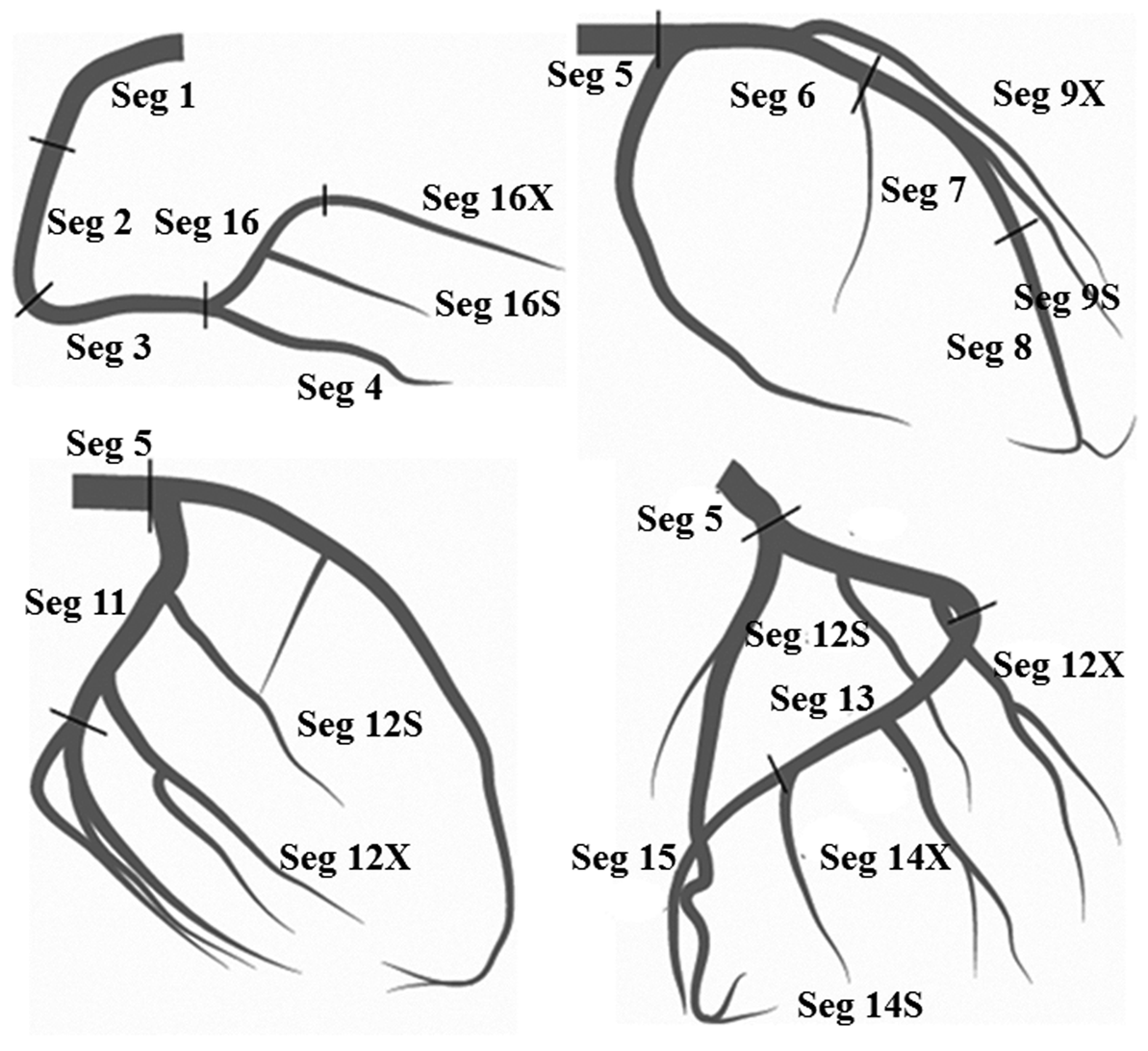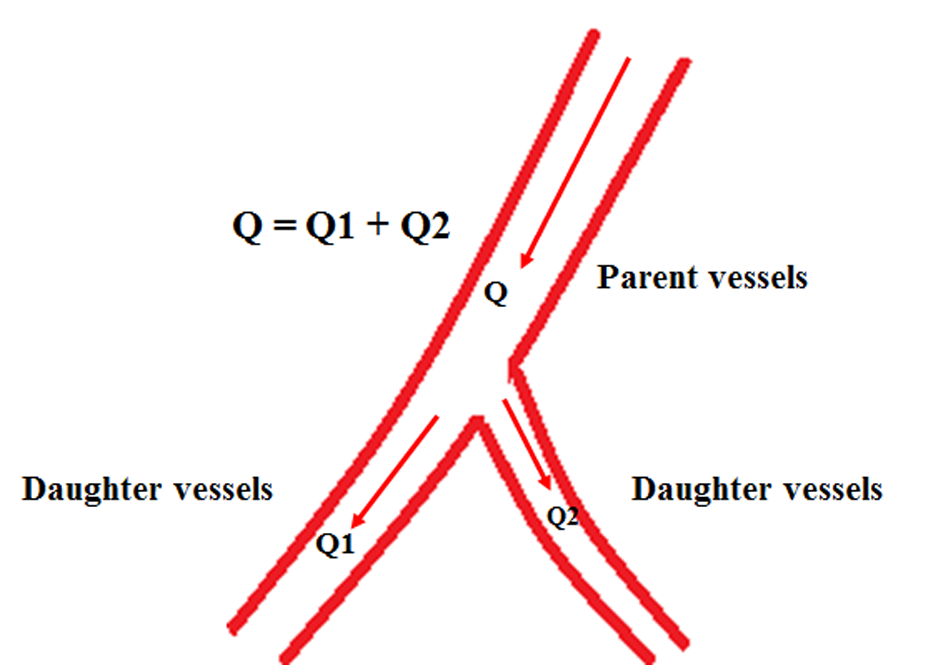Modified definitions of the coronary artery tree segments
The definition of the coronary artery tree segments is based on the classification proposed by the AHA (11) and on the modification for the ARTS I and II trials (12). We have further modified this arterial segmentation system to adapt to our angiographic scoring system. We have adopted most nomenclatures of coronary artery tree segments in the SYNTAX score (13). In our angiographic scoring system, definitions for segments 16 series, 7 series, 9 series, 12 series, 14 series, and segments 11, 13 and 15 have been modified as shown in Figure 8.

Figure 8. Fully-fledged 3 major epicardial coronary arteries of RCA, LAD and LCX. Segments 16 series, 7 series, 9 series, 12 series, 14 series, and segments 11, 13 and 15 have been modified.
Seg 1. Right coronary artery (RCA) proximal: adopted as in the SYNTAX score;
Seg 2. RCA mid: adopted as in the SYNTAX score;
Seg 3. RCA distal: adopted as in the SYNTAX score;
Seg 4. Posterior descending artery (PDA) adopted as in the SYNTAX score;
Seg 16. Main posterolateral vessels (PLVs) from RCA: adopted as in the SYNTAX score.
Seg 16a. First PLV of the same size from segment 16.
Seg 16b. Second PLV of the same size from segment 16.
Seg 16X. Major PLV from segment 16 regardless of its origin.
Seg 16S. Minor PLV from segment 16 regardless of its origin with a preset segment difference of 0.5 compared with major PLV.
Seg 16&. Only large PLV from segment 16.
Seg 16c. Obtuse marginal from segment 16, supplying a portion of inferolateral or even anterolateral wall.
Seg 5. Left main (LM) adopted as in the SYNTAX.
Seg 6. Proximal left anterior descending artery (LAD): First third of LAD from its origin to the apex, usually ending at the first major septal branch.
Seg 7 series. Middle LAD: Second third of LAD from its origin to the apex.
Seg 8. Distal LAD: Remaining third of LAD from its origin to the apex, usually wrapping around the apex.
Seg 9a. First diagonal (Dx) of the same size from Seg 6 or 7.
Seg 9b. Second Dx of the same size from Seg 6 or 7.
Seg 9X. Major Dx from Seg 6 or 7 regardless of its origin.
Seg 9S. Minor Dx from Seg 6 or 7 regardless of its origin, with a preset segment difference of 0.5 compared with Seg 9X.
Seg 9&. Only large Dx usually from Seg 6.
Seg 7&. Mid LAD giving rise to an only large Dx
Seg 7X. Mid LAD giving rise to a major Dx.
Seg 7S. Mid LAD giving rise to a minor Dx.
Seg 7E. Mid LAD giving rise to a Dx of the same size.
Seg 7. Mid LAD giving no rise to any Dx. The only large Dx usually arises from segment 6.
Seg 11. Proximal left circumflex (LCX): adopted as in the SYNTAX score.
Seg 12a. First obtuse marginal (OM) of the same size from LCX running over the general area of the obtuse margin of the heart.
Seg 12b. Second OM of the same size from LCX running in the same direction as Seg 12a.
Seg 12X. Major OM from LCX running over the general area of the obtuse margin of the heart regardless of its origin.
Seg 12S. Minor OM from LCX running in the same direction as 12X regardless of its origin, with a preset segment difference 0.5 compared with Seg 12X.
Seg 12&. Only large OM from LCX running over the general area of the obtuse margin of the heart.
Seg 13. Distal LCX: adopted as in the SYNTAX score.
Seg 14b: Second PLV of the same size from Seg 13.
Seg 14X: Major PLV from Seg 13 regardless of its origin.
Seg 14S: Minor PLV from Seg 13 regardless of its origin, with a preset segment difference of 0.5 compared with Seg 14S.
Seg 14&: The only large PLV from Seg 13 regardless of its origin.
Seg 15: PDA from LCA adopted as in the SYNTAX score.
Up to “2 blood vessels” sufficiently cover all the variations of branches arising from a main branch
We set the LAD and its diagonals as an example. If the LAD gives rise to 2 diagonals, these 2 diagonals only have two possibilities: the same or different sizes. If the LAD gives rise to 3 diagonals, we still think of them as “2 diagonals” by way of combining two out of the three diagonals into one. The “2 diagonals” with the same size will be named Seg 9a and 9b, respectively; the “2 diagonals” with different sizes will be named Seg 9X and 9S, respectively, according to their sizes. Branches arising from LCX or RCA have been approached in the same way.
Law of flow conservation (14)
According to the law of flow conservation, a parent vessel equals the sum of its daughter vessels in terms of blood flow, thus, Q=Q1+Q2. (Figure 9). Weighting factor assignment strictly follows this law, therefore, a parent vessel always equals the sum of its daughter vessels in terms of weighting factors.

Figure 9. Law of flow conservation: a parent vessel equals the sum of daughter vessels in terms of blood flow. Arrow indicates blood flow direction.
Weighting factors assigned to LAD, LCX and RCA in the benchmark type.
According to the 17 myocardial segmentation model in the benchmark type (9), the LAD supplies 7 segments: 1, 2, 7, 8, 13, 14, and 17; the LCX supplies 5 segments: 5, 6, 11, 12, and 16; and the RCA supplies 5 segments: 3, 4, 9, 10, and 15. Correspondingly, weighting factors are 7.0 for LAD, 5.0 for LCX, and 5.0 for RCA in this benchmark type (9). Specifically, LAD divides into LADex (excluding diagonals) and diagonals, supplying 4 segments and 3 segments, respectively; RCA divides into PDA and PLVs, supplying 2 segments and 3 segments, respectively. Correspondingly, weighting factors are 3.0 for diagonals, 2.0 for PDA, and 3.0 for PLVs, respectively, in this benchmark type. See table 2.
Table 2. Weighting factors assigned to coronary artery tree segments in the benchmark type.
RCA | Average RCA dominant | ||
Dx | Inter. | ||
LAD | Ave. | ||
LM | seg 5 | LM | 12 |
LAD | seg 6 | Prox. LAD | 7 |
seg 7& | Mid LAD& | 6 | |
seg 7X | Mid LADx | 4.75 | |
seg 7S | Mid LADs | 4.25 | |
seg 7E | Mid LADe | 4.5 | |
seg 7 | Mid LAD | 3 | |
seg 8 | Distal LAD | 2 | |
seg 9X | Major Dx | 1.75 | |
seg 9S | Small Dx | 1.25 | |
seg 9a | Equal Dx | 1.5 | |
seg 9b | Equal Dx | 1.5 | |
seg 9& | Comb. Dx | 3 | |
LCX | seg 11 | Prox. Cx. | 5 |
seg 12X | Major OM | 2.75 | |
seg 12S | Small OM | 2.25 | |
seg 12a | Equal OM | 2.5 | |
seg 12b | Equal OM | 2.5 | |
seg 12& | Comb. OM | 5 | |
seg 13 | Distal Cx. | NULL | |
seg 14X | Major PLV off Cx. | NULL | |
seg 14S | Small PLV off Cx. | NULL | |
seg 14a | Equal PLV off Cx. | NULL | |
seg 14b | Equal PLV off Cx. | NULL | |
seg 14& | Comb. PLV off Cx. | NULL | |
seg 15 | PDA off Cx. | NULL | |
RCA | seg 1 | Prox. RCA | 5 |
seg 2 | Mid. RCA | 5 | |
seg 3 | Distal RCA | 5 | |
seg 4 | PDA off RCA | 2 | |
seg 16 | Main PLV off RCA | 3 | |
seg 16X | Major PLV off RCA | 1.75 | |
seg 16S | Small PLV off RCA | 1.25 | |
seg 16a | Equal PLV off RCA | 1.5 | |
seg 16b | Equal PLV off RCA | 1.5 | |
seg 16& | Comb. PLV off RCA | 3 | |
seg 16c | OM off RCA | NULL |
Notes: Values in the golden cells are according to the assignment of the 17 myocardial segments to one of the 3 major epicardial coronary arteries recommended by AHA Scientific Statement in the benchmark pattern of coronary circulation. Values assigned in the green cells strictly obey the matrix operations elaborated below immediately. Values assigned in the yellow cells are fractions of those marked with &’, among which values marked with X’ or S’ with a difference of 0.5. RCA indicates right coronary artery; LAD, left anterior descending; LCX, left circumflex; Dx, diagonals; Comb. Dx, all the diagonals arising from LAD; PDA, posterior descending artery; and Comb. PLVs, all the posterolateral vessels arising from LCX or RCA. NULL indicates unavailability of blood vessels in this type of coronary artery circulation.
Segment weighting factor relationships in the benchmark type as shown in the table 2
According to the law of flow conservation, we can derive the following equations:
LM equals the sum of LAD and LCX in terms of blood flow, which is briefly expressed as Seg 5=Seg 6+Seg 11
Seg 5=Seg 6+Seg 11;
For RCA,
Seg 16=Seg 16&+Seg 16c;
Seg 16&=Seg 16X+Seg 16S = Seg 16a+Seg 16b=2Seg 16a=2Seg 16b;
Seg 1=Seg 2=Seg 3=Seg 4+ Seg 16;
For LCX,
Seg 12&=Seg 12X+Seg 12S=Seg 12a+Seg 12b=2Seg 12a=2Seg 12b;
Seg 13&=Seg 11-seg 12&;
Seg 13&=Seg 14X+Seg 14S= Seg 14a+Seg 14b=2Seg 14a=2Seg 14b
For LAD,
Seg 9&=Seg 9X+Seg 9S=Seg 9a+Seg 9b=2Seg 9a or 2Seg 9b
4.0=Seg 6-Seg 9&
6.0=Seg 6-Seg 9&+Seg 15
Seg 8=2.0;
Seg 7=Seg 8+1.0;
Seg 7E=Seg 8+Seg 9a or 9b+ 1.0;
Seg 7X=Seg 8+Seg 9X+ 1.0;
Seg 7S=Seg 8+Seg 9S+ 1.0; and
Seg 7&=Seg 8+Seg 9&+1.0.
For PDA zero,
Seg 15=6-(Seg 6-Seg 9&);
For PDA only to Super RCA dominant,
Seg 4=6-(Seg 6-Seg 9&).
These segment weighting factor relationships revealed above in the benchmark type are also applicable to those in non-benchmark types of coronary artery circulations.
发表评论:
◎Welcome to participate in the discussion, please post your views here and exchange your views.